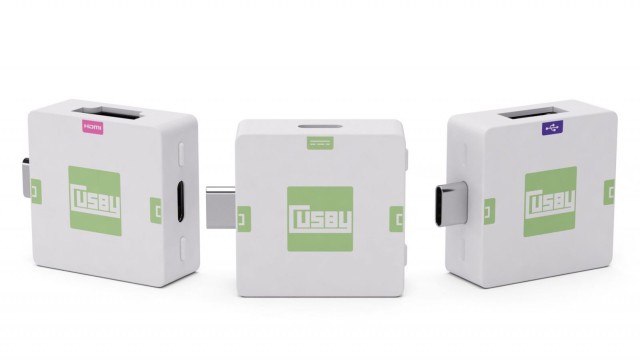You can’t stop staring at the new 12-inch MacBook, especially the gold one. It’s lighter and smaller and while it has all the computing power of your suddenly-bulkier model, you’re not sure about life with a single USB-C port.
A Miami startup, led by an electrical engineer, has designed adapters that will allow you to plug in all your peripherals and then gradually cut back as you move to a more wireless future.
The Cusby Building Blocks plug into a USB-C port with each offering a more traditional plug-in, like the current standard USB-A port, another with an HDMI video-audio port or another with an extra USB-C port.

Photo: Cusby
USB-C is the future standard and Apple earlier this year introduced a new, thinner MacBook with a single USB-C port. USB-C offers a single connection for everything with a bi-directional cord that delivers more power with a uniform plug that eliminates the hassle of figuring out which side is up. A number of adapters are available on Google and in the Apple Store.
The Cusby blocks became available for pre-order Tuesday morning on Indiegogo, with a variety of donation levels to help the company raise $15,000. Backers for $65 can get two blocks and a USB-C extension cable.
“We’re invested in our devices and the future is wireless, but we’re not really there yet,” Cusby creator Albert Garvett told Cult of Mac. “The new MacBook design is beautiful. You don’t want to put a lot of bulky stuff around it. We’re trying to find a solution that fits everybody’s needs.”
Garvett said he believed the C needed to be upfront in Cusby and the Y at the end of brand name is “just to make it friendly.”
Future blocks will be friendly to Thunderbolt cables and photographers with a plug-in media card reader.



7 responses to “Cusby adapters give you the building blocks to adjust to USB-C”
Nice solution, but I still want nothing to do with the new macbooks. The pro is plenty thin enough, with twice the power that I need.
True, but there is a market for each of the Macs. You and me happen to like the Pro.
Sorry to burst their bubble, but a Thunderbolt module won’t work. USB cannot be converted to Thunderbolt; it only works the other way around. TB devices ONLY work on TB ports.
They are referring to Thunderbolt 3 which uses UBC-C connectors when its released next year
Doesn’t matter. The underlying technology doesn’t work that way. Thunderbolt devices still can only be used on Thunderbolt ports.
Incorrect, not from Skylake onwards, the same UBS-C ports will be able to use Thunderbolt or USB 3.1+ devices. There will not be separate USB-C ports for each. USB-C is nothing more than a connector type, it is not a protocol and further implementations of Thunderbolt and USB will be sharing ports. The confusion arrives when customers start buying Thunderbolt 3 for their Macbook which doesn’t support it.
Wow you’re an idiot! USB IS a separate protocol!
And you have everything backwards. Thunderbolt 3 has been announced to be using USB-C connectors and is integrating USB 3.1 Gen 2 support. That means that anyone that wants to have the port that uses both will have to pay for the TB controller chip, and it will be called a Thunderbolt port. Ports that don’t have the TB chip (like the new MacBook, for now) will be standard USB ports and won’t be compatible with Thunderbolt devices. This is Intel’s way of getting everyone to finally support Thunderbolt. Either way, people will still have to pay attention to the symbol on their port because it’s a given that not everyone will pay up for the TB chip. USB ports cannot support Thunderbolt because the protocols send data in different ways that aren’t compatible. It’s the same reason that you can’t use FireWire devices on USB ports (adapters can be found because China, but they don’t work).